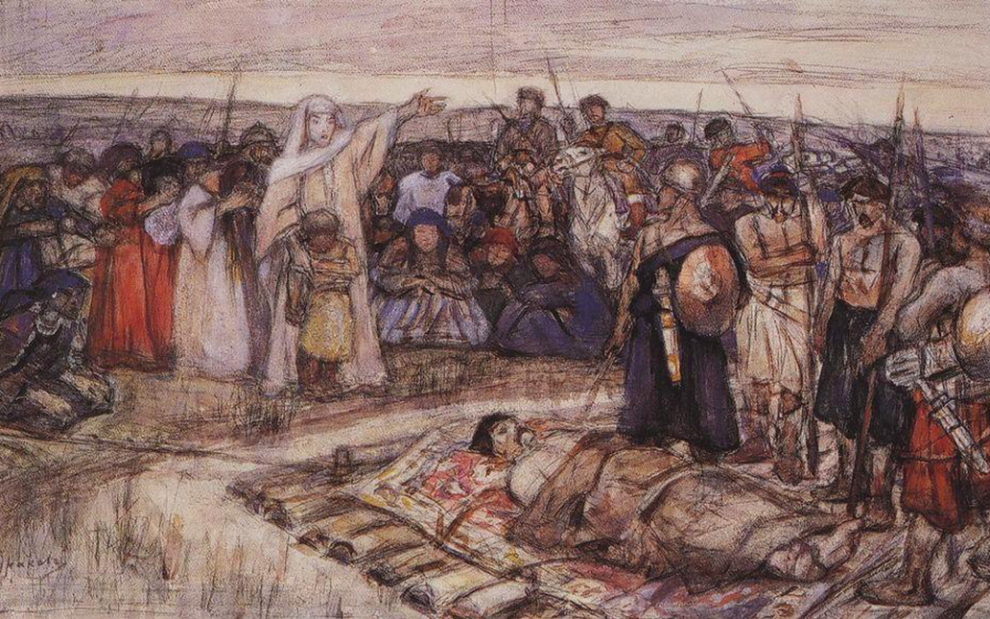American Catholics sometimes feel conflicted about Halloween. The very name is a contraction for “All Hallows Evening,” but somehow a Christian vigil for the saints became a secular holiday that features witches, monsters, spooks, and hobgoblins. How do frightening creatures of the imagination fit into a religion that extols the values of attaining personal holiness and union with God?
Instead of dressing in black, wearing sheets, and decorating pumpkins, some Catholics prefer to turn to their favorite saints. Devils are transformed into archangels. Witches and wizards exchange wands for prop swords, becoming St. Joan or St. George. Some who enjoy Halloween gore dress up as martyrs drenched in fake blood.
The assumption is that saints, being holy, are safe. Even the martyrs, under the blood and despite various missing body parts, are presumed to be good, decent people who lived upstanding lives right up until they were thrown to the lions. But saints aren’t all sweetness and holiness—some fit in just fine with Halloween creepiness.
There are plenty of scary saints in the church’s canon—men and women who eventually became saints, but who you might not want to meet on a dark night under the light of a full moon. Their stories show Christians that the road to holiness isn’t necessarily lined with flowers and covered in rainbows, that the hope of heaven is for everyone—even for scary people. Let’s look at a few of the church’s scary people.
St. Pulcheria (c. 398–453)
The daughter of an Eastern Roman emperor, Pulcheria was named guardian and regent for her younger brother, Theodosius II. As regent, she had a large role in forming the new emperor’s harsh measures undertaken against Jews in the region. Pulcheria wasn’t canonized, the modern process being hundreds of years in the future. Given her anti-Semitic activity, which wasn’t just scary but evil, it’s doubtful she’d pass the historical review candidates for sainthood receive today.
Pulcheria may be better known for her conflicts with Nestorius, Archbishop of Constantinople. When Nestorius tried to strip Pulcheria and her sisters of their ecclesial privileges, banishing them from the altar to an upper balcony of the church, Pulcheria led the women in throwing cabbages at Nestorius as he led worship. Her opposition to Nestorius’s denial of the Virgin Mary’s role as the Theotokos (God bearer) may be one reason she was given the honor of sainthood, despite some very unsaintly acts.
St. Olga of Kiev (c. 890–969)
Mass murderers are not generally thought of as saints, but another Catholic monarch attained sainthood despite her brutal reprisal against her husband’s murderers. Not much is known about Olga before her marriage to her husband, Igor. When Igor fell afoul of a neighboring tribe that didn’t take kindly to his demands for money and murdered him, Olga used her position as her young son’s regent to take revenge on the tribe, reportedly directing her men to slaughter thousands of people.
Later on in her reign, Olga converted to Christianity, taking the mother of the Emperor Constantine as her patron saint. She tried to bring Kiev along with her into Christianity. By that time, though, her son was ruling in his own right and refused. Her son did allow Olga to build churches and agreed not to persecute converts.
Christina the Astonishing (1150–1224)
Christina hasn’t been the only holy person to throw herself into extreme asceticism and stringent self-mortification. St. Rose of Lima, for example, discouraged her suitors by damaging her own face. In Christina’s case, though, her behavior included wandering the streets in rags, jumping into fires and emerging unharmed, offering herself up to be mauled by wild dogs, and tossing herself into briar patches.
Christina’s “career” as a public penitent began after a near-death experience. After a seizure, she was presumed dead. During the funeral liturgy, she suddenly rose from her coffin, insisting that she’d chosen to come back to Earth to rescue souls from purgatory. Her bizarre behavior, which might have been the result of either undiagnosed mental illness or traumatic brain injury following her seizure, was so unsettling to her community that she was suspected of being possessed by the devil. Eventually, she settled down somewhat, especially when ordered to do so by religious authority. Although widely venerated as a saint, she has never been canonized.
Bl. Bartolo Longo (1841–1926)
If you’ve ever wondered if Satan worshippers can go to heaven, the answer is yes. As a student studying law at the University of Naples, Bartolo Longo fell in with a bad crowd. At the time in Italy, anti-papal sentiment was high and Longo’s contemporaries were demonstrating for Italian unification. Longo’s peers at the university were involved in spiritualism and occult activity, and Longo himself became a satanic priest.
Longo’s participation in satanic ritual didn’t bring him spiritual peace, though. Quite the opposite. He reportedly suffered from anxiety and depression. Fortunately, he listened to a friend who urged him to see a Catholic priest. The priest helped Longo return to his Catholic roots, and introduced him to the rosary. He spent much of the rest of his life promoting the rosary as a means of attaining inner peace.
Jacques Fesch (1930–1957)
Jacques Fesch first achieved infamy as a thief and murderer, albeit an inept one. He dreamed of sailing around the world in a boat, which sounds harmless enough, but when he couldn’t convince his parents to buy him his boat, he decided to steal the money he needed. His victim called for the gendarmes, who set off in hot pursuit of Fesch. The young man panicked and shot one of the cops, killing him.
Fesch’s lawyer wasn’t able to save his client from being condemned to death, but did finally manage to break through Fesch’s apathy and convince him to repent for his crime. While in prison awaiting execution, Fesch kept a spiritual journal. He also managed to reconcile with his family. His last journal entry read, “In five hours, I will see Jesus!” Despite some controversy, given the notoriety of his crime, his sanctity is being investigated.
Hard as it may be to imagine some of these men and women to be saints, sanctity isn’t dependent on formal recognition by the church. All who die in God’s friendship eventually will be saints, even if they must detour through purgatory on the way to heavenly glory. In some cases, these saints’ stories may be difficult to digest. How can we possibly find inspiration in the story of a saint who committed grave evils and may never have faced human justice?
Nonetheless, these stories show us that no matter how far from grace we may have fallen, there is probably a saint out there who has fallen further and managed, by the grace of God, to rise again. Their stories give us hope that we too might join them someday in glory.
All Saints Day is the feast day of all of the saints of God, including those who started out as murderers and devil worshippers.
Image: Wikimedia Commons/Princess Olga meets the body of her husband, great prince Igor, Vasily Surkov, 1915














Add comment